
Damian with colleagues Brendan Murphy (left), Ulf Linnemann (right)
and two of Ulf’s doctoral students, examining rocks of the Rheic Ocean
in the Prague Basin of the Czech Republic in 2002.
Geologic Community Honors Damian Nance
When Distinguished Professor Emeritus Damian Nance took early retirement from the Ohio University Geological Sciences Department in 2018—after 38 years at Ohio University and an academic career spanning 44 years, colleagues from all over the world came together to mark the occasion and pay tribute to his many contributions to geology.
They came together to honor the man who put the puzzle pieces together to paint a whole new picture of Earth—like traveling back in time and watching its oceans and land masses gyrate as tectonic forces shaped and reshaped the Earth’s crust, eventually giving us the current seven continents that appear when we spin the globe.
But throughout that faraway time that Nance studied, supercontinents seemed to dominate Earth’s evolution.
Nance’s time travels through the geologic record of the Earth take us down the two main pathways of his research—the supercontinent cycle and the history of ocean closing and mountain building on either side of the North Atlantic in the time window between about 650 and 260 million years ago.
In geologic time, that’s somewhere between the Earth’s first animals up through the Age of Dinosaurs.
Even as scientists developed modern instruments to probe the Earth, they chose the ancient language of Greek to describe to its very, very ancient history.
Pannotia (“all south”) and Pangea (“all land”) are the names given to the two most recent of Earth’s supercontinents, during which time most of the world’s continents were united into a single landmass. They formed about 600 and 300 million years ago, respectively, and it was during their assembly, long before the Atlantic Ocean formed, that mountain building in what we now call the North Atlantic took place.
Count in that mountain building the Appalachian Mountains, home to Ohio University, from where Nance advanced a theory that would reshape the world. In the supercontinent Pangea, Athens, Ohio, was close to the center of the world, bordering the collision zone produced as what we now know as Europe and North American came together and rose up.
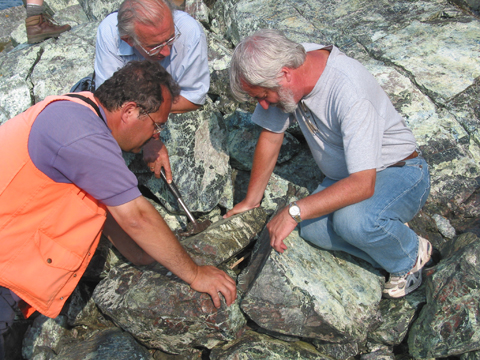
Damian Nance with Turkish colleague Erdin Bozkurt examining a preserved
section of the floor of the Rheic Ocean on the Lizard peninsula in
Cornwall, UK, in 2005.
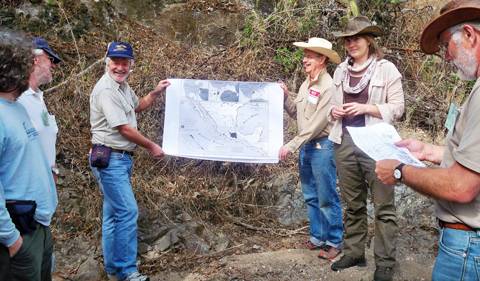
Damian with Universidad Nacional Autónoma de México colleague
Duncan Keppie explaining the Acatlán Complex on an International
Geoscience Programme fieldtrip in southern Mexico in 2012.
Nance’s Legacy—the Supercontinent Cycle
It is for first recognizing the supercontinent cycle that Nance is best known.
Indeed, so important has the supercontinent cycle become that a recent paper submitted to the Geological Society of London by 31 internationally renowned geologists advocates adapting the geologic timescale, the very calendar of geology, to the evidence preserved in the rock record of the cycle various phases.
Jointly proposed by Nance and fellow OHIO geologist Tom Worsley, with the late Judith Moody (then at the Battelle Institute) in 1982, just two years after Nance’s arrival in Athens, Ohio, the cycle describes the now-substantiated view that much of Earth’s history has been punctuated by the episodic assembly and breakup of supercontinents—with profound consequences to the planet’s geologic, climatic, geochemical and biological evolution.
The cycle is also believed to have controlling influences on the circulation of the mantle—that part of the Earth’s interior that lies beneath the crust on which we live. Accordingly, the well-established and widely known supercontinent Pangea is viewed as simply the most recent in a whole series of supercontinents, the assembly and breakup of which have been repeated on a time scale of roughly half a billion years.
Like the revolutionary theory of plate tectonics, the supercontinent cycle is a unifying concept, controlling many aspects of Earth system science through its fundamental influence on the development of the Earth’s crust, oceans, atmosphere and biosphere. It has been described as having had a greater influence on the rock record than any other geologic phenomena, and its recognition is arguably the most important advance in Earth science since plate tectonics was proposed in the 1960s.
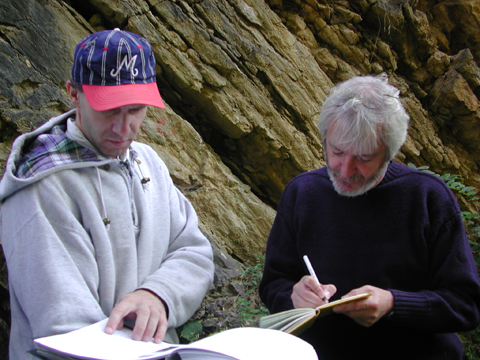
Damian Nance with Czech colleague Petr Kraft taking notes on the Rheic
Ocean geology of the Prague Basin in the Czech Republic in 2002.
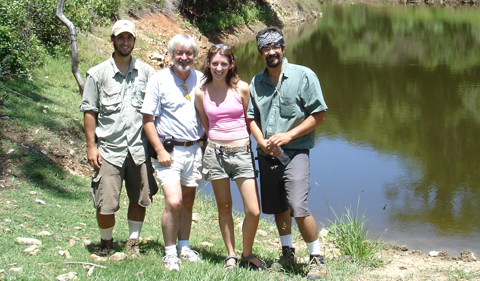
Damian Nance with graduate students Kyle Shalek (left), Kathryn Grodzicki
(now MacWilliam) and Hector Hinojosa-Prieto in southern Mexico in
2005.
Testing His Hypothesis—OHIO Students on the Ground in Canada…
But just as Alfred Wegener’s hypotheses of Pangea and Continental Drift in 1912 (the precursor to plate tectonics) were dismissed by most scientists of his day, so too was Nance’s work on the supercontinent cycle in the 1980s.
Indeed, almost 20 years would pass before the theory gained traction, and it is only since the millennium, as more and more data supporting the notion accumulated, that the cycle has gained widespread acceptance and Nance’s contribution has been recognized.
This supporting data derives from many branches of geology, but some has come from plain old-fashioned fieldwork that Nance subsequently conducted with his career-long colleague, Brendan Murphy at St. Francis Xavier University in Nova Scotia.
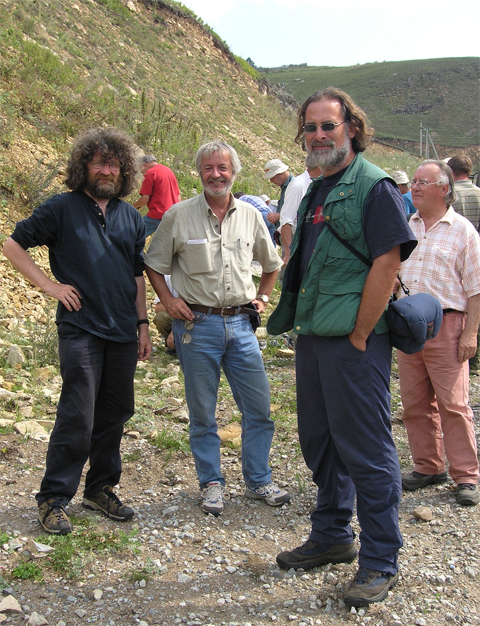
Damian Nance with colleagues (left to right) Brendan Murphy (Canada), Rob
Strachan (UK) and Jean-Pierre Lefort (Fance) in the Ural Mountains of
Russia in 2005.
Understanding that an idea as controversial and potentially significant as the supercontinent cycle would need substantiation beyond the data on which it was originally based, Nance chose to take his students to examine the mountain belts of the North Atlantic region that, according to his theory, should record the assembly of the last two supercontinents.
So began Nance’s second main avenue of research. He started this work in Canada on a region of ancient mountain building that he thought might be linked to the assembly of the hypothetical supercontinent Pannotia some 600 million years ago. Known as the Avalon terrane or Avalonia after the Avalon Peninsula in Newfoundland, the region covers much of Atlantic Canada and southeastern New England, and continues on the other side of the Atlantic (which had not yet opened—picture this as one connected landmass) into Britain and Europe. Belts of related geology also extend southward into the Carolinas. As Nance hoped, the geology of these regions proved to be consistent with the existence of Pannotia at the time that he and Worlsey had proposed.
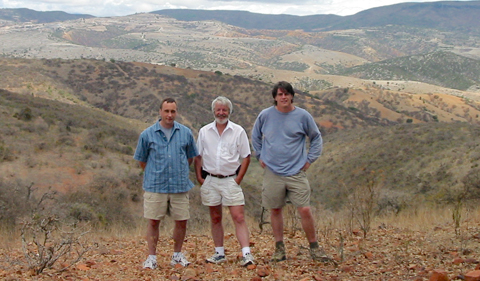
Damian with two former students, Dr. Brent Miller (Texas A&M) (left)
and John Malone (Regional Operations VP, Key Energy Services) (right),
revisiting the Acatlán Complex, Mexico, on a field trip in 2003.
… on to Mexico, and a Gathering of Geologists around the World
From Canada, where his work later won him the 2019 Gessner Medal from the Atlantic Geoscience Society, Nance took his students south to a region of Mexico in the Puebla and Guerrero provinces known as the Acatlán Complex. Here he thought they might find a record of the breakup of Pannotia and the subsequent assembly of the next supercontinent, Pangea.
And through their pioneering studies of this poorly known region, they did just that, adding another piece of evidence in support of the existence of the supercontinent cycle.
This led Nance to approach the problem on a much grander scale with a much bigger topic – the Rheic Ocean. This great body of water separated Africa and the southern continents from Europe and North America some 350 to 470 million years ago, and it was the closure of this ocean that produced the Appalachian Mountains as we know them today and assembled the greater part of Pangea by bringing these continents together.
This was not a topic that could be tackled by the fieldwork of just a few people in Mexico, Canada or anywhere else, but one that required a compilation of the work of hundreds of geologists in many fields and many countries, because the geology linked to the Rheic Ocean ran from southern Mexico to Maritime Canada, and from Ireland and Morocco to Turkey and beyond.
So for this project, Nance sought the help of his long-time colleague Ulf Linnemann at the Senckenberg Museum of Mineralogy and Geology in Dresden, and together they successfully secured a five-year grant from UNESCO’s International Geoscience Programme to organize a series of international meetings. Held in Mexico, Canada, the UK, Germany, the Czech Republic, Spain, Portugal, Morocco, Italy, Turkey, Russia, and South Africa, these meetings brought together scientists from all over the world working on all aspects of the history of the Rheic Ocean. And through the international collaboration these meetings gave rise to, Damian was able to produce the compilation he needed. The history of the Rheic Ocean provided yet more evidence in support of the supercontinent cycle.
New Methods and Modeling—and the Theory Holds
But it was from data from a great many fields—from geophysics and the history of Earth’s magnetism, from modeling of the Earth’s dynamic interior, from studies of billion-year-old rocks and the record they preserve, and from the ever-increasing precision of age dating—that the existence of past supercontinents was demonstrated and their geography reconstructed. And the timing of these supercontinents and the consequences of their assembly and breakup were found to closely match those that Nance and Worsley—two scientists from Ohio University—had proposed fully 30 years earlier.
Although “retired,” Nance has been anything but idle, traveling the world giving invited lectures, delivering a semester-long course on the supercontinent cycle at Charles University in Prague, giving Zoom talks since the pandemic took hold, and writing. Over the past three years he has completed 37 papers, published a book with another in press, and edited three volumes. Fittingly, the most recent of his articles, published in January 2021, was an invited contribution to the second Edition of the Encyclopedia of Geology, a 12-page entry that was missing from the first edition entitled simply “The Supercontinent Cycle.”
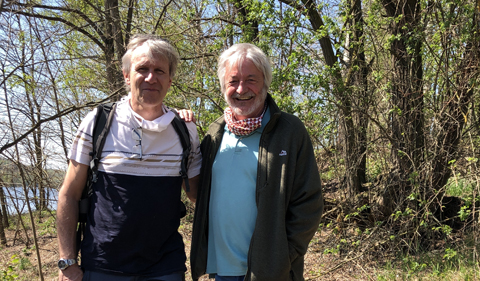
Still at it! Damian Nance and colleague Petr Kraft from Charles University in Prague on an outcrop of Rheic Ocean ironstones in Bohemia in 2020.
Seeking a lasting tribute, Nance’s colleagues and the Geological Society of London arranged—in addition to the May 2019 conference—to produce a special publication in his honor that brought together an extraordinary array of geologists who had been influenced by his work or shared similar interests.
To quote from the volume’s abstract, this 664-page book, which carries the same title as the conference and was published in January 2021, “celebrates the career of R. Damian Nance. It features 27 articles, with more than 110 authors based in 18 different countries. The wide range of topics presented in this volume mirrors the breadth and depth of Damian’s contributions, interests and expertise. Like Damian’s papers, the contributions range from the predominantly conceptual to detailed fieldwork, but all are targeted at understanding important tectonic processes. Their scope not only varies in scale from global to regional to local, but also in the range of approaches required to gain that understanding. Thus, there are contributions on the processes responsible for the formation and breakup of supercontinents, the controversial amalgamation of Pannotia, the generation and destruction of Paleozoic oceans, and the development of the Appalachian–Ouachitan–Caledonide–Variscan orogens. In addition to fieldwork, the approaches to gain that understanding include examining the relationships between stratigraphy and structural geology, precise geochronology, geochemical and isotopic fingerprinting, geodynamic modelling, regional syntheses, palaeogeographic modelling, and plain, old-fashioned arm-waving!


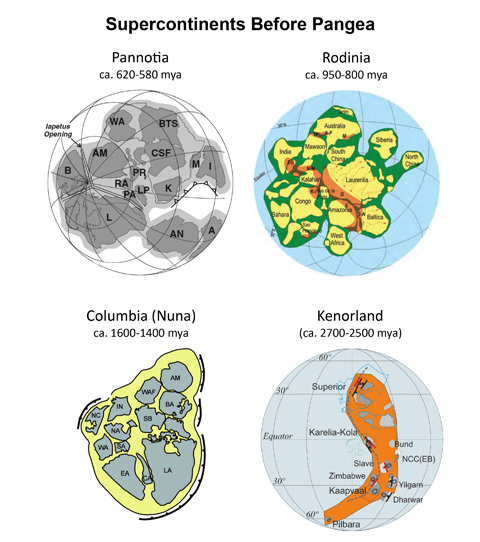
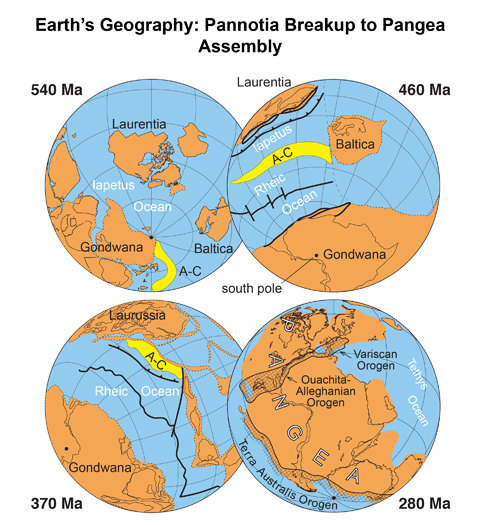
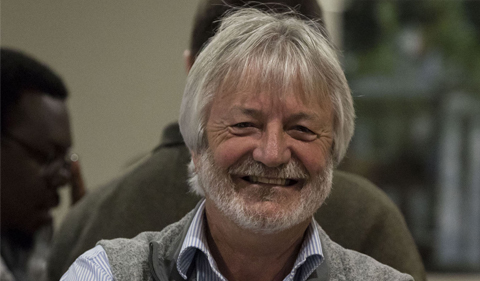
















Comments